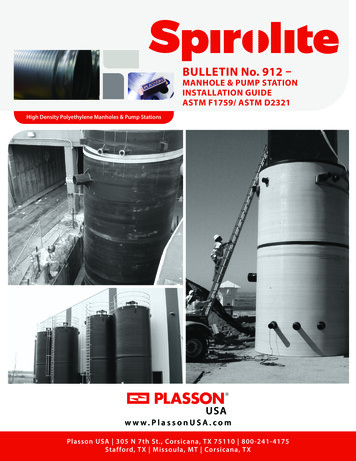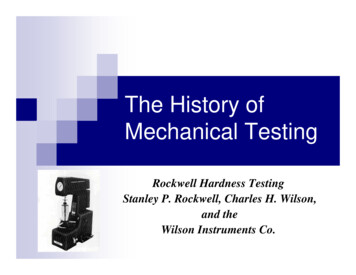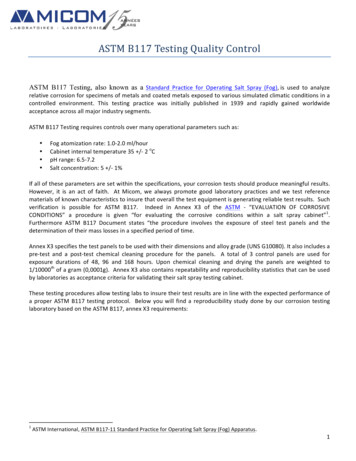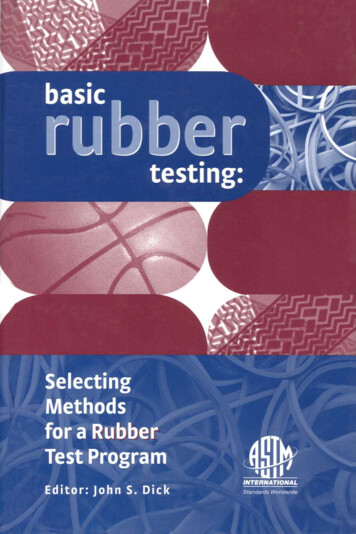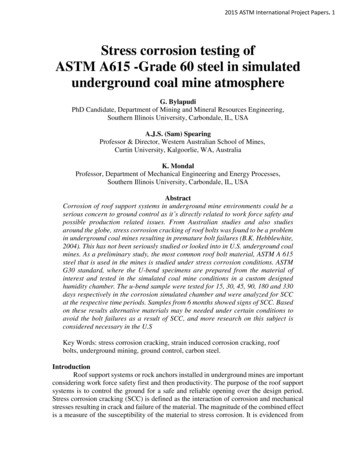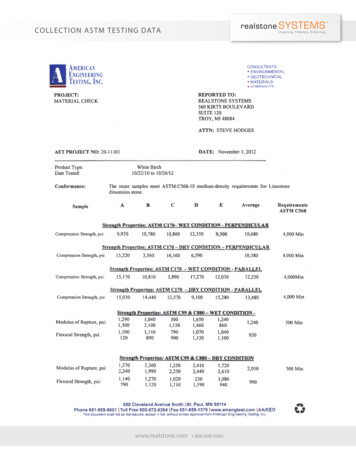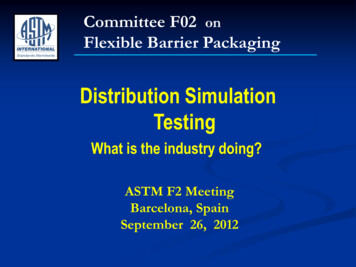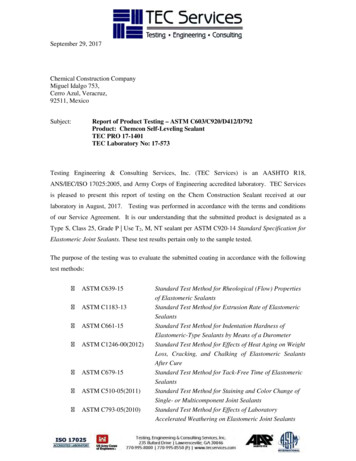
Transcription
September 29, 2017Chemical Construction CompanyMiguel Idalgo 753,Cerro Azul, Veracruz,92511, MexicoSubject:Report of Product Testing – ASTM C603/C920/D412/D792Product: Chemcon Self-Leveling SealantTEC PRO 17-1401TEC Laboratory No: 17-573Testing Engineering & Consulting Services, Inc. (TEC Services) is an AASHTO R18,ANS/IEC/ISO 17025:2005, and Army Corps of Engineering accredited laboratory. TEC Servicesis pleased to present this report of testing on the Chem Construction Sealant received at ourlaboratory in August, 2017. Testing was performed in accordance with the terms and conditionsof our Service Agreement. It is our understanding that the submitted product is designated as aType S, Class 25, Grade P Use T2, M, NT sealant per ASTM C920-14 Standard Specification forElastomeric Joint Sealants. These test results pertain only to the sample tested.The purpose of the testing was to evaluate the submitted coating in accordance with the followingtest methods:ASTM C639-15ASTM C1183-13ASTM C661-15ASTM C1246-00(2012)ASTM C679-15ASTM C510-05(2011)ASTM C793-05(2010)Standard Test Method for Rheological (Flow) Propertiesof Elastomeric SealantsStandard Test Method for Extrusion Rate of ElastomericSealantsStandard Test Method for Indentation Hardness ofElastomeric-Type Sealants by Means of a DurometerStandard Test Method for Effects of Heat Aging on WeightLoss, Cracking, and Chalking of Elastomeric SealantsAfter CureStandard Test Method for Tack-Free Time of ElastomericSealantsStandard Test Method for Staining and Color Change ofSingle- or Multicomponent Joint SealantsStandard Test Method for Effects of LaboratoryAccelerated Weathering on Elastomeric Joint Sealants
Report of Sealant Testing on Chem Construction SealantTEC Laboratory No: 17-573 ASTM C719-14 ASTM C794-15 ASTM C603 ASTM D412 ASTM D792September 29, 2017Standard Test Method for Adhesion and Cohesion ofElastomeric Joint Sealants Under Cyclic Movement(Hockman Cycle)Standard Test Method for Adhesion-in-Peel ofElastomeric Joint SealantsStandard Test Method for Extrusion Rate and ApplicationLife of Elastomeric SealantsStandard Test Methods forVulcanized Rubber and Thermoplastic Elastomers—TensionStandard Test Methods for Density and Specific Gravity(Relative Density) of Plastics by DisplacementASTM C639 – Vertical & Horizontal DisplacementA closed-end stainless steel channel 6.00 inches in length, 0.75 inches wide, and 0.50 inches indepth was conditioned at 4.4 2 C for two hours. At the end of the conditioning period, the channelwas filled with the subject product and returned to the conditioning chambers. At the end of a fourhour period, the sealant was examined for flow properties. Test results are reported in Table 2.ASTM C1183 – Extrusion RateThe subject product was transferred to a 6 fluid oz polyethylene cartridge fitted with a polyethylenenozzle 2.5 inches in length with a 0.125 inch diameter orifice. The filled cartridge was placed intoan air powered caulking gun attached to an air supply capable of maintaining a pressure of 40 1psi. The sealant was extruded into a pre-weighed cup for a period of 1 minute. The weight of thecup was subtracted from the final weight to determine the mass of sealant extruded in one minute.Test results are reported in Table 2.ASTM C661 – Durometer HardnessTwo 3.00 inch x 6.00 inch x 0.25 inch specimens were cast on aluminum plates and allowed to curefor 21 days prior to testing – 7 days at standard conditions of 73.4 3.6ºF and a relative humidityof 50 2%, followed by 7 days at 100 3.6 F and a relative humidity of 95%, and finally 7 days atstandard conditions. The Shore A Durometer was firmly pressed into each specimen. Readingswere recorded when the pressure foot contacted the surface of the specimen. Three readings wererecorded from three areas. Individual and average test results are reported in Table 3.ASTM C1246 – Heat AgingThree 6.00” x 3.00” 20 gage aluminum panels were cleaned and weighed to the nearest 0.01 grams.The subject product was extruded into a 5.00” x 1.50” template and struck off at a thickness of 1/8”on each aluminum panel. The specimens were cured for 28 days at standard conditions of 73.4 3.6ºF and a relative humidity of 50 4%. At the end of the cure period, each specimen wasweighed to the nearest 0.01 grams. Two of the three specimens were placed in a forced-draft ovenat 158 3.6ºF for 21 days. The third specimen remained at standard conditions to serve as acontrol. At the end of the 21 day heat-aging period, the specimens were removed from the oven andallowed to cool for one hour. All three specimens were weighed again to calculate the percentweight loss during the heat aging process. Test results are reported in Table 4.Page 2 of 10
Report of Sealant Testing on Chem Construction SealantTEC Laboratory No: 17-573September 29, 2017ASTM C679 – Tack Free TimeChem Construction Sealant was extruded into a rectangular template 1/8” in depth having insidedimensions of 3.75” x 1.00” on an aluminum plate. The specimen was tested by lightly touchingthe surface of the sealant with a film of polyethylene wrapped over a finger. When the sealant wasable to be touched lightly without adhering to the polyethylene, the sealant specimen was coveredwith a polyethylene strip and loaded with a 30 gram brass weight. After a 30 second period, theweight was removed and the polyethylene strip was removed by pulling it 90 away from thesealant. The sealant was considered tack free when no sealant adhered to the strip after the 30second loading period. The specimen was tested every minute for the first ten minutes after thetemplate was filled and struck off, every 2 minutes for the next ten minutes, every 5 minutes for thenext 160 minutes, then every hour until the tack-free time was achieved. Test results are reported inTable 2.ASTM C510 – Stain & Color ChangeFour 5.00 inch x 1.50 inch x 0.25 inch mortar tiles were prepared and allowed to cure for 4 hours at73.4 3.6 ºF and a relative humidity of 50 4%. Chem Construction Sealant was applied to two ofthe mortar tiles at a thickness of 0.25 inches and allowed to cure for 24 hours. The other two tilesserved as a control. The two coated specimens and the two control specimens were placed insidethe QUV accelerated weathering machine for 100 hours under 340 nm UV light. Specimens werevisually examined for stain and color change. No stain or color change was observed in the mortartile substrates. The Chem Construction Sealant specimens exhibited no staining or cracking.ASTM C793 – Accelerated WeatheringThe subject product was extruded into a template having inside dimensions of 5.00” x 1.50” onthree 6.00” x 3.00” x 0.01” aluminum plates and struck off at a thickness of 1/8”. The specimenswere allowed to cure for 21 days at standard conditions of 73.4 3.6 ºF and a relative humidity of50 4%. Two specimens were placed inside the QUV accelerated weathering machine for 250hours under 340 nm UV light. One specimen remained unexposed at standard conditions to serveas a control. Specimens were examined after the UV exposure period for cracking anddiscoloration. The sealant exhibited minimal signs of cracking. All three specimens and a 0.5”steel mandrel were then placed in a freezer at -15 4ºF for 24 hours. At the end of this period,each specimen was bent 180 along its width around the mandrel, sealant side outward, within onesecond. Specimens were examined for cracks in the bend area. The specimens exhibited minimalsigns of cracking.ASTM C719 – Adhesion & CohesionSix specimens were prepared and tested in accordance with ASTM C719. Three specimens wereprepared by bonding together two 3.0” x 1.0” x 1.0” mortar substrates with a 2.0” x 0.5” x 0.5”bead of Chem Construction Sealant such that the sealant was flush with the substrates on one sideand offset 0.5” on all other sides. Three specimens were prepared by bonding together two 3.00” x0.25” x 0.25” anodized aluminum substrates with a 2.0” x 0.5” x 0.5” bead of the subject productso that the sealant was flush with the substrates on one side and offset 0.5” on all other sides.Mortar substrates were weathered to a CSP-3 surface profile prior to bonding. Specimens wereallowed to cure for 21 days prior to testing – 7 days at standard conditions of 73.4 3.6ºF and aPage 3 of 10
Report of Sealant Testing on Chem Construction SealantTEC Laboratory No: 17-573September 29, 2017relative humidity of 50 2%, followed by 7 days at 100 3.6 F and a relative humidity of 95%,and finally 7 days at standard conditions. The specimens were then immersed in water for a periodof 7 days. At the end of the immersion period, the specimens were removed from the water andallowed to dry completely at standard conditions. The specimens were compressed to a joint widthof 0.325” and placed in an oven at 158 F for seven days. The specimens were removed from theoven, allowed to cool, and placed into the Hockman Cycle test apparatus. The specimens weresubjected to ten cycles of compression to 0.325” and extension to 0.675” at a rate of 0.125” perhour. Finally the specimens were subjected to ten cycles of extension at -15 F and compression at158 F. Test results are reported in Table 2.ASTM C794 – Adhesion-in-PeelFour test specimens were prepared on mortar substrates and four test specimens were prepared onanodized aluminum substrates and tested at an age of 21 days. A bead of the subject product 4.00inches in length was applied to each substrate. A 1.00” x 10.00” strip of aluminum 20-mesh wasimmediately placed on the sealant and lightly tapped such that it was embedded in the wet sealant 2mm from the substrate surface. A second bead of sealant was applied and a tooling device was usedto strike it off at a depth of 4 mm, such that the wire mesh was embedded uniformly at the midpointof the sealant depth. The specimens were allowed to cure at standard conditions of 73.4 3.6ºF anda relative humidity of 50 2% until the time of testing. Immediately prior to testing, the loose endof the wire mesh strip was bent back 180 and the sealant-substrate interface was cut slightly by arazor. The mortar substrate was secured to the base of the testing apparatus and the mesh strip wassecured by a grip. The screen was pulled at a rate of 2.0 inches/minute for a total of 1 minute. Thepeak force was indicated by a load cell. The failure mode was considered adhesive if the sealantpulled away from the substrate and cohesive if the tear propagated through the sealant. Averageand peak peel strength and failure mode is reported in Table 5.ASTM D412 – Tensile Strength & ElongationFive type one tensile strength specimens were cast by extruding FX-573 into a mold having anominal thickness of 0.25 inches and a gage length of 2.00 inches. The specimens were allowed tocure for 28 days at ambient laboratory conditions of 73.4 2ºF and a relative humidity of 50 2%.Specimens were loaded into the testing apparatus and elongated at a rate of 20 0.2 in/min untilultimate failure. Test results are reported in Table 6.Page 4 of 10
Report of Sealant Testing on Chem Construction SealantTEC Laboratory No: 17-573September 29, 2017Table 1 – Chem Construction Sealant – Product InformationMix IDChem Construction SealantLot #AA1601228Kit TypeCartridge, Single ComponentMaterial Temperature72.0 FAmbient Temperature73.9 FHumidity52%TypeSGradePClass25UseT2, M, NTTable 2 – Chem Construction Sealant Test Results tPropertyHorizontal @4.4 CRheological Flow after 4hoursconditioningShore AASTMC1246ASTMC679ASTMC510100 hours QUVA 340 - Cycle 1ASTMC793250 hours QUVA 340 - Cycle 1ExtrusionRate @ 40 psiDurometerHardnessVisualChangeCompared toControlHeat Aging % WeightLossTack FreeTimeStain & ColorChangeAcceleratedWeathering UV Exposure& FreezingAgeAverage ResultPlasticProduct exhibitssmooth and levelsurface withoutdeformationPlastic78.3 mL/minute21 Days15Specification perASTM C920Grade P:Product exhibitssmooth and levelsurface withoutdeformationGrade P: 10 mL/minuteUse T2: 25Use NT: 60Pass/FailPassPassPassNo Cracking orChalkingRating 0No Cracking orChalkingPass1.1% 7.0%PassPlasticPass 72 hoursPass7 daysNo Stain orColor ChangeNo Stain or ColorChangePass21 daysMinimalCrackingNo cracks greaterthan C793Fig.1 Example #2PassPassPass28 daysASTMC719Mortar SubstrateBondDurability21 days0.0 in2 1.5 in2debonded –cumulative 3specimensASTMC794Mortar SubstrateAdhesion inPeel - PeelForce21 days34.70 lbf 5 lbfPage 5 of 10
Report of Sealant Testing on Chem Construction SealantTEC Laboratory No: 17-573September 29, 2017Table 3 – ASTM C661 – Shore A Hardness Test ResultsSpecimenIdentificationArea 10.125”Area 20.250”Area age15Table 4 – ASTM C1246 – Heat UncoatedAluminumSubstrateWeight eWeightLoss(%)Visual Observations1.1Rating 0No cracking or chalkingRating 0No cracking or chalkingTable 5 – ASTM C794 – Adhesion-in-PeelSpecimenIdentificationChem ConstructionSealant – MortarSubstrateFailureModePeel 96Cohesive36.478AveragePeel Force(lbf)34.70Table 6 – ASTM C412 – Tensile Strength and 0.01903.93020621611922019Avg.Page 6 of 10
Report of Sealant Testing on Chem Construction SealantTEC Laboratory No: 17-573September 29, 2017Table 7 – ASTM C603 – Extrusion Rate at 50 psiSpecimenIdentificationTest 1Test 2Test ble 8 – ASTM D792 – Specific nstructionSealant1.14SummaryBased on res
ASTM D792 Standard Test Methods for Density and Specific Gravity (Relative Density) of Plastics by Displacement ASTM C639 – Vertical & Horizontal Displacement


